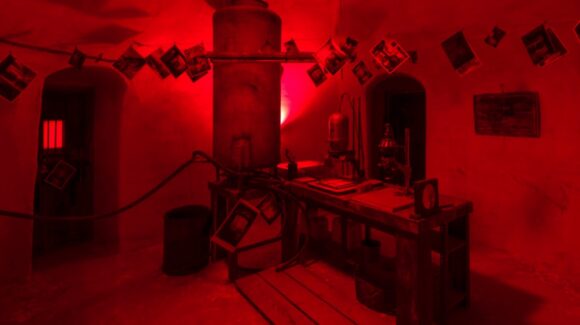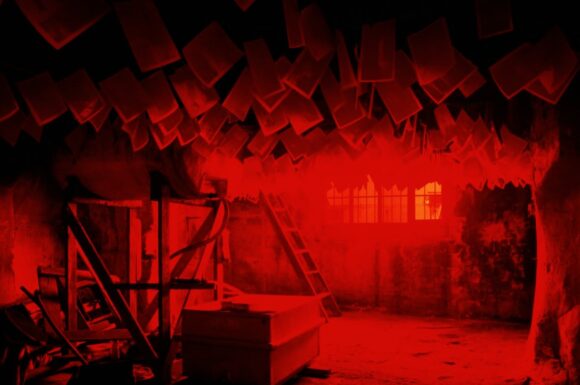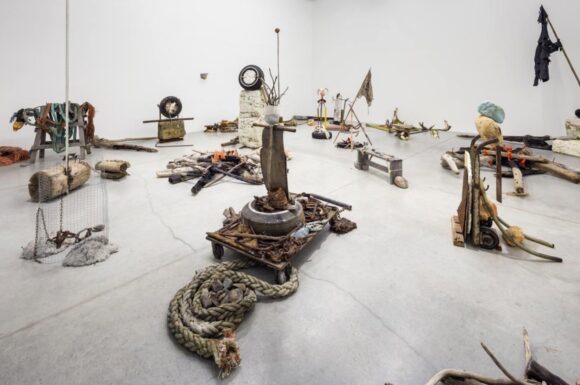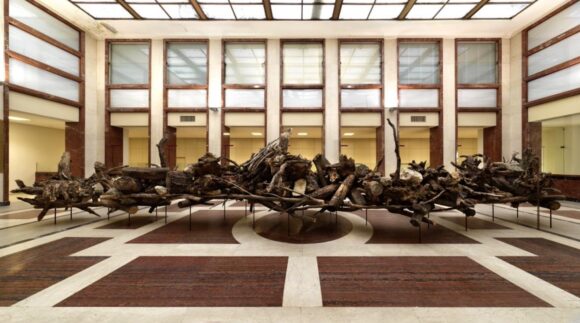
Do you remember when they assassinated Osama bin Laden? It was 2011. May. I remember it because a couple of weeks later the Venice Biennale opened, and representing Britain, unforgettably, was Mike Nelson.
Inside the British pavilion, in a dankly atmospheric installation, Nelson had built a labyrinth of desolate Middle Eastern spaces through which we wandered, lost and befuddled, like a band of cut-price Theseuses searching for a Minotaur. Or perhaps like a helicopter-load of US navy Seals sent into a mysterious compound in Pakistan to track down Bin Laden.
One room had some discarded prayer mats. Another, a bed that had recently been slept in. A third, a creepy photographic dark room. Planned, stocked and built months before the assassination, Nelson’s installation felt uncannily like the shaky pictures of Bin Laden’s compound we had been watching over and over again on the evening news. Never mind Mystic Meg — this is Mystic Mike.
It all came flooding back at the Hayward Gallery, where Nelson is being treated to something described on paper as a retrospective, but which feels in the flesh like a takeover of the building by a bunch of post-apocalyptic squatters. Mad Max has flown over from Australia, and he and his fellow bikers have made themselves at home in a huge concrete bunker on the South Bank.

You enter through a side door into a storeroom filled with spooky junk. Doors. Gates. Floorboards. It’s the Hayward, but not the bits of it where they usually have shows. More like somewhere down in the basement, where no one ever goes. Who put the junk here? What’s it for? Nobody answers. So off you blunder down a scruffy corridor, up a wooden ramp, and into another installation.
This one feels as if it’s below deck on a ship that has run aground. The previous occupants must have left in a hurry because the lights are still on and the fans are turning. This is where they slept: see the mattresses. This is their homemade gambling den: see the tarot cards. Here’s the bar. And this weird room, filled with voodoo skulls and videos of the Maharishi, must be where they prayed for help. And where their hopes were dashed.
All this has to be imagined, of course. Nelson’s method is to thrust you into mysterious spaces and force you to wander around them, opening doors, reading clues. Mice in experiments must feel like this.
A higher power is testing us. Controlling us. Directing us. Either that, or the end of the world really has happened and there really is just me and you left, blundering through the ruins.

If the dark labyrinths were constructed only for fun they would still constitute excellent use of the Hayward Gallery: you’re never too old for a ghost train ride. What lifts Nelson’s output on to a higher plane is the secretive ambitions his art harbours to comment on this angsty little world of ours.
The nautical installation with the voodoo room was originally shown in 2001. Its name is The Deliverance and The Patience and it was inspired by the shipwreck of a boat packed with indentured labourers heading for the Jamestown colony in Virginia in 1609. Beached in Bermuda, the labourers set about building a free society for themselves. But their masters organised the construction of two new ships — the Deliverance and the Patience — to continue the journey to Virginia. Shakespeare later used some details of the shipwreck in The Tempest.
Quite what Nelson is saying here about these resonant events is unclear; he’s the guy who sets the clues on Only Connect, not the contestant who solves them. We’re in a movie without a plot, a labyrinth without an exit, a play without a denouement. Doing all the talking are decayed textures and sullen atmospheres, creepy rooms and claustrophobic corridors. All we can really sense with certainty is that the world we live in has been fast-forwarded to its future, and it’s not good news.
As this is a retrospective, as well as a floor-to-ceiling takeover of the Hayward (The Deliverance and The Patience was created just before 9/11; Mystic Mike has refashioned it for this showing with a new layout), the exhibition goes on to reveal the other things Nelson gets up to when he isn’t sending us poking about in dark corridors.

Upstairs, there’s a heroic-feeling gallery in which bits of giant machinery — a mechanical hacksaw, a surface grinder, a farmyard hay rake — have been put on pedestals and turned into monuments to a passing industrial age. Yanked out of their rightful context, held up for our inspection, the lumbering ready-mades become accidental sculptures: spiky, sombre, patinated, nostalgic. Being remembered, you feel, are not just the days when Britain had a manufacturing industry but also the hard dark lives of all the disappeared folk pushing the buttons and pressing the levers. Mystic Mike has gone sad on us, again.
I forgot to mention, the show is entitled Extinction Beckons.
Mike Nelson, Hayward Gallery, London SE1, until May 7
